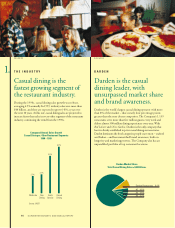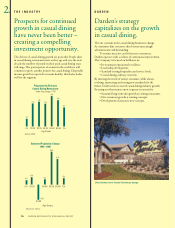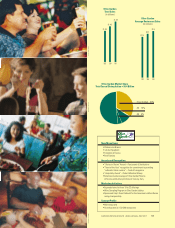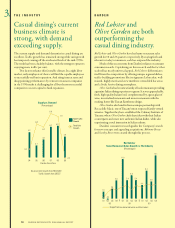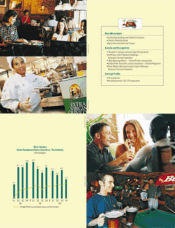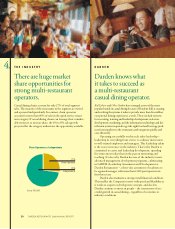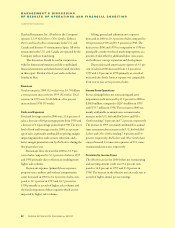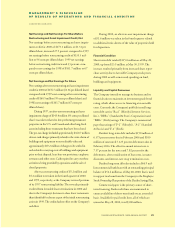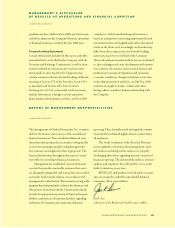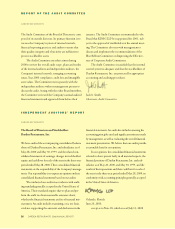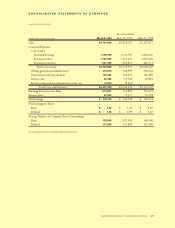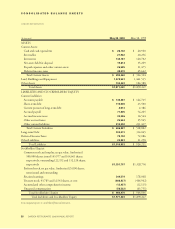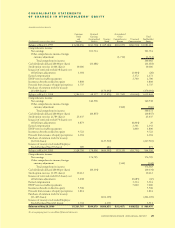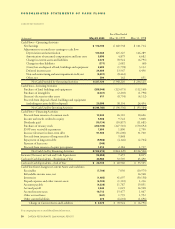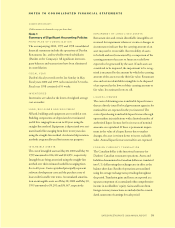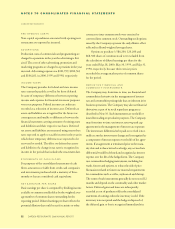Red Lobster 2000 Annual Report Download - page 26
Download and view the complete annual report
Please find page 26 of the 2000 Red Lobster annual report below. You can navigate through the pages in the report by either clicking on the pages listed below, or by using the keyword search tool below to find specific information within the annual report.
MANAGEMENT’S DISCUSSION
OF RESULTS OF OPERATIONS AND FINANCIAL CONDITION
DARDEN RESTAURANTS
Net Earnings and Net Earnings Per Share Before
Restructuring and Asset Impairment Credit, Net
Net earnings before net restructuring and asset impair-
ment credit for 2000 of $173.1 million, or $1.31 per
diluted share, increased 27.9 percent, compared to 1999
net earnings before restructuring credit of $135.3 mil-
lion or 96 cents per diluted share. 1999 net earnings
before restructuring credit increased 33 percent, com-
pared to net earnings for 1998 of $101.7 million or 67
cents per diluted share.
Net Earnings and Net Earnings Per Share
Net earnings after net restructuring and asset impairment
credit for 2000 of $176.7 million ($1.34 per diluted share)
compared with 1999’s net earnings after restructuring
credit of $140.5 million (99 cents per diluted share) and
1998’s net earnings of $101.7 million (67 cents per
diluted share).
During 1997, an after-tax restructuring and asset
impairment charge of $145.4 million (93 cents per diluted
share) was taken related to low-performing restaurant
properties in the U.S. and Canada and other long-lived
assets including those restaurants that have been closed.
The pre-tax charge included approximately $160.7 million
of non-cash charges primarily related to the write-down of
buildings and equipment to net realizable value and
approximately $69.2 million of charges to be settled in
cash related to carrying costs of buildings and equipment
prior to their disposal, lease buy-out provisions, employee
severance and other costs. Cash required to carry out these
activities is being provided by operations and the sale of
closed properties.
After-tax restructuring credits of $5.2 million and
$5.2 million were taken in the fourth quarter of 2000
and 1999, respectively, as the Company reversed portions
of its 1997 restructuring liability. The reversals primarily
resulted from favorable lease terminations in 2000 and
due to the Company’s decision to close fewer restaurants
than identified for closure as part of the initial restructuring
action in 1999. The credits had no effect on the Company’s
cash flow.
During 2000, an after-tax asset impairment charge
of $1.6 million was taken in the fourth quarter related
to additional write-downs of the value of properties held
for disposition.
Financial Condition
Short-term debt totaled $115.0 million as of May 28,
2000, up from $23.5 million at May 30, 1999. The
increase resulted primarily from increased share repur-
chase activity due to favorable Company stock prices
during 2000 as well as increased spending on land,
buildings and equipment.
Liquidity and Capital Resources
The Company intends to manage its business and its
financial ratios to maintain an investment grade bond
rating, which allows access to financing at reasonable
costs. Currently, the Company’s publicly issued long-
term debt carries “Baa1” (Moody’s Investor Services,
Inc.), “BBB+” (Standard & Poor’s Corporation) and
“BBB+” (Fitch) ratings. The Company’s commercial
paper has ratings of “P-2” (Moody’s), “A-2” (Standard
& Poor’s) and “F-2” (Fitch).
Darden’s long-term debt includes $150 million of
6.375 percent notes due in February 2006 and $100
million of unsecured 7.125 percent debentures due in
February 2016. The effective annual interest rate is
7.57 percent for the notes and 7.82 percent for the
debentures, after consideration of loan costs, issuance
discounts, and interest-rate swap termination costs.
Darden’s long-term debt also includes a $66.9 mil-
lion commercial bank loan with an outstanding principal
balance of $52.6 million as of May 28, 2000, that is used
to support two loans from the Company to the Employee
Stock Ownership Plan portion of the Darden Savings Plan.
Commercial paper is the primary source of short-
term financing. Bank credit lines are maintained to
ensure availability of short-term funds on an as-needed
basis. Available fee-paid credit lines, all of which are
unused at May 28, 2000, total $300 million.
DARDEN RESTAURANTS 2000 ANNUAL REPORT 23



